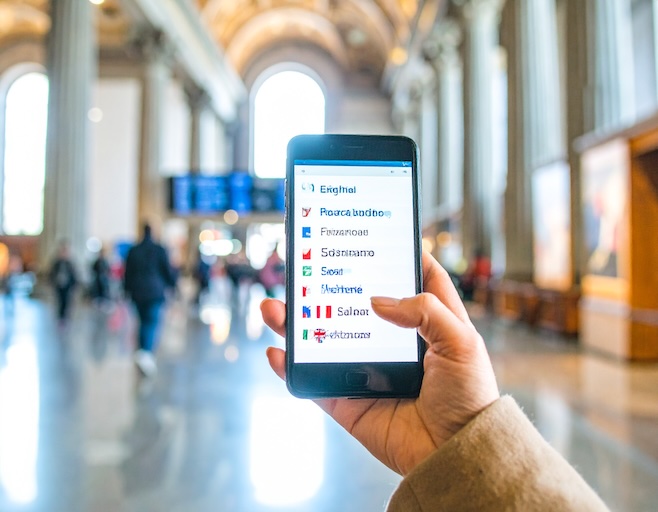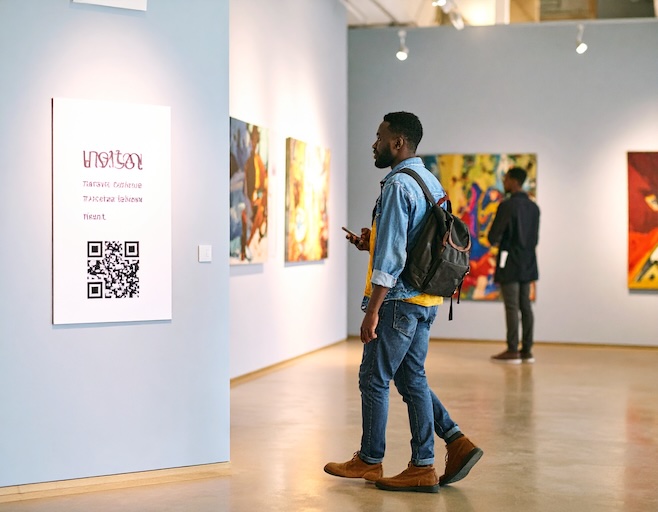 August 20, 2025
August 20, 2025
Language shouldn’t be a barrier to wonder. Yet in many museums, international visitors miss context, staff become ad-hoc translators, and reviews read “great collection, hard to follow.” This guide shows how to build a multilingual experience by design—raising ratings and removing friction without increasing headcount.
The Hidden Cost of Language Friction
- Visitors rush through objects without the story that makes them memorable.
- Front-of-house queues grow when guests ask for translations.
- Reviews mention confusion more than curation—dragging down overall scores.
Designing for language access from day one reverses this pattern: satisfaction climbs, dwell time rises, and staff time goes back to hospitality, not translation.
Principle: Multilingual by Design (Not an Afterthought)
Multilingual by design means planning content, access, and support so language is never a bottleneck:
- Multilingual museum audio available on visitors’ own phones (BYOD – Bring Your Own Device).
- Consistent museum translation across audio, labels, maps, and ticketing emails.
- Lean workflows so the team edits once and updates ripple to every language.
Pillar 1: BYOD Audio That Works Everywhere

- Self-serve access: QR codes or short exhibit numbers; no app sign-up walls.
- Language picker first: Offer 6–10 common languages (e.g., English, Français, Español, Deutsch, Italiano, 简体中文, 日本語, 한국어).
- Offline-first: Preload tracks at the entrance so basements and thick walls aren’t a problem.
- Right-sized tracks: 60–120 seconds per stop, chaptered; easy to pause when a gallery gets busy.
- Accessibility baked in: Transcripts, large tap targets, and high-contrast mode help everyone.
Practical note: Place QR codes at ~120–140 cm height, left of the main label, with a clear “Scan → Choose language → Play” micro-diagram.
Pillar 2: Smart Translation Workflow (Fast, Consistent, Maintainable)
- Approve a master script in the source language (object names, dates, rights).
- Draft at scale with AI, then light human review for key galleries or “hero” objects.
- Maintain a living glossary (people, places, technical terms, style choices).
- Voice strategy: Use high-quality synthetic voice for breadth; reserve human narrators for flagship stops.
- Edit once, publish everywhere: Script changes auto-regenerate translated audio and transcripts.
Outcome: Every language delivers the same story arc and calls-to-action—no more “lost in translation” moments.
Pillar 3: Wayfinding & Support That Don’t Need Extra Staff
- One universal entry page: “Choose your language → Choose your tour.”
- Icon-led signage: Language endonyms (Français, Español) plus ISO codes (FR, ES) reduce confusion.
- No-login start: Ask for app install or email only after the first successful play.
- Desk script: Staff point to a small card: “Scan here, pick your language.” That’s it.
Operations: Do More With the Same Team

- Front-of-house: De-stress queues; fewer translation requests.
- Curators & educators: Edit the master script; translation + audio rendering handle the rest.
- Marketing: Promote “Audio in 8+ languages” on the website, Google Business Profile, and entry signage.
Rollout Plan (6–8 Weeks, Lean Team)
Weeks 1–2: Plan & Script
- Pick 30–50 stops that tell a coherent narrative.
- Draft short, conversational scripts (reading age 9–12), with clear “look-here” cues.
Weeks 3–4: Translate & Voice
- AI-assist translations; human review for priority stops.
- Generate synthetic voice for all; record human voice for hero objects if desired.
Weeks 5–6: Publish & Signage
- Launch the web audio guide (BYOD) with offline preloading.
- Print QR placards with language icons and micro-instructions.
Weeks 7–8: Test, Tweak, Announce
- Pilot with multilingual volunteers; fix pacing and terminology.
- Update the homepage and visitor map: “Multilingual audio now available.”
FAQs
Do we need to buy devices?
No. BYOD eliminates purchase, charging, and cleaning. Keep a few loaners for edge cases.
Our Wi-Fi is unreliable—will this work?
Yes. Offline-first playback lets visitors cache tracks at the entrance.
How many languages should we start with?
Begin with 6–8 based on visitor mix; expand as patterns emerge in reviews and ticketing data.
Will this add to staff workload?
Setup takes planning; after launch, the team mainly maintains the master script while the pipeline updates translations and audio.
A museum’s job is to make meaning accessible. With multilingual museum audio and a maintainable museum translation workflow, international guests get the full story, staff regain time, and ratings reflect the experience—not the hurdles.


